Lumbar Disc Bulge
Updated:
(Also known as Bulging Disc, Disc Prolapse, Slipped Disc, Prolapsed Disc, Herniated Disc, Intervertebral Disc Injury, Sprained Disc)
What is a lumbar disc bulge?
The lumbar spine (i.e. lower back) comprises of many bones known as vertebrae, each of which is separated by a disc (figure 1). The disc comprises of many layers of strong connective tissue wrapping around the disc. In the middle of the disc lies a soft jelly-like substance which is capable of changing shape. When this jelly-like substance protrudes from the disc due to a tear in several layers of the connective tissue, this is known as a lumbar disc bulge (figure 1).
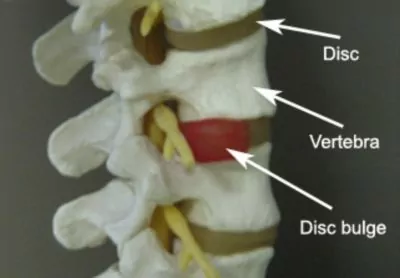
To understand the mechanism of a bulging disc, it is useful to liken the disc to a vanilla slice. Imagine a vanilla slice wrapped in five layers of sandwich wrap. The top and bottom layers of pastry represent the vertebra (bones), the custard represents the jelly-like substance of the disc and the sandwich wrap represents the connective tissue around the disc. If you were now to pinch the front of that vanilla slice, you could imagine, the custard would squeeze towards the back of the vanilla slice and may tear two or three layers of sandwich wrap at the back of the vanilla slice. As a result the custard is no longer supported as effectively at the back of the vanilla slice and therefore bulges out at this location. In the disc, the situation is the same. Bending forward closes down the front of the disc, pushing the jelly-like substance within the disc towards the back. Overtime or suddenly, this may tear several layers of connective tissue at the back of the disc resulting in a disc bulge.
Lumbar disc bulges most commonly occur in those who are 20 to 50 years of age. The lowest disc of the spine (L5/S1) is most commonly affected with the disc above (L4/L5) the second most common.
Causes of a lumbar disc bulge
There are 4 primary activities in everyday life which, in isolation, or combination, typically cause lumbar disc bulges provided they are forceful, repetitive or prolonged enough. These include: bending forwards, sitting down, lifting and twisting. Occasionally, lumbar disc bulges may occur following a trivial movement involving bending forward such as picking up a small object or sneezing. In these instances, the disc has normally been subject to repetitive or prolonged bending, sitting, lifting or twisting forces leading up to the incident.
Signs and symptoms of a lumbar disc bulge
Patients with a lumbar disc bulge may experience a sudden onset of back pain or discomfort during the causative activity, however, it is also common for patients to experience pain and stiffness after the provocative activity, particularly the next morning. Symptoms are typically felt in the lower back and may be located centrally, on one side or on both sides of the spine. The patient may experience pain radiating down one or both legs into locations such as the buttocks, thigh, lower leg or foot (sciatica). In some cases, symptom location may vary with pain moving down the leg (i.e. peripheralising), or towards the spine (i.e. centralising) with certain activity.
Muscle spasm, pins and needles, numbness or weakness may also be present. In more severe cases, patients may appear to stand with their spine noticeably out of alignment, be unable to straighten their spine or may walk with a marked limp. Symptoms are generally exacerbated with activities involving lifting, bending forwards, prolonged sitting, or when moving from sitting to standing (e.g. getting out of the car particularly after a long drive). Coughing, sneezing, twisting and activities using the arms in front of the body (e.g. housework / gardening etc.) may also aggravate symptoms. Pain, tenderness or a bruised sensation are often experienced on firmly touching the affected level of the spine (usually by an experienced practitioner) and any affected muscles (often the gluteals and erector spinae i.e. the buttock and lower back). Patients with a lumbar disc bulge often experience pain that is worse first thing in the morning.
Diagnosis of a lumbar disc bulge
A thorough subjective and objective examination from a physiotherapist is usually sufficient to diagnose a lumbar disc bulge. Investigations such as an MRI or CT scan may be required in some cases, to confirm diagnosis.
Treatment for a lumbar disc bulge

Members Only ContentBecome a PhysioAdvisor Member to gain full access to this exclusive content. For more details see Become a Member. Already a member? Login Now
Prognosis of a lumbar disc bulge
In patients with the perfect balance of activities, the lumbar disc may be pushed into position in as little as three days. Typically, however, patients take approximately 2 to 3 weeks to push their disc back ‘in’. Once the disc is ‘in’, the patient should be pain free and have full movement. However, the torn connective tissue at the back of the disc only begins to heal from this point. It takes approximately six weeks of consistently keeping the disc ‘in’ to allow the torn tissue to heal to approximately 80% of its original strength.
Contributing factors to the development of a lumbar disc bulge
Several factors may contribute to the development of a lumbar disc bulge. These need to be assessed and corrected with direction from the treating physiotherapist and may include:
- poor core stability
- a sedentary lifestyle
- being overweight
- muscle tightness
- muscle weakness
- joint stiffness
- poor lifting technique
- poor posture (particularly when sitting)
- a lifestyle involving large amounts of sitting, bending, lifting or twisting
- inadequate recovery periods from sitting, bending, lifting or twisting activities
Physiotherapy for a lumbar disc bulge
Physiotherapy treatment for a lumbar disc bulge is vital to ensure an optimal outcome and may comprise:
- soft tissue massage
- electrotherapy (e.g. ultrasound)
- lumbar taping
- the use of a back brace
- mobilization
- traction
- the use of a lumbar roll for sitting
- dry needling
- exercises to push the disc back ‘in’ and to improve strength, core stability and flexibility
- education
- activity modification advice
- biomechanical correction
- ergonomic advice
- clinical Pilates
- hydrotherapy
- a functional restoration program
- a gradual return to activity program
Other intervention for a lumbar disc bulge
Despite appropriate physiotherapy management, a small percentage of lumbar disc bulges fail to improve and may require other intervention. This may include further investigations such as an X-ray, CT scan or MRI, pharmaceutical intervention, cortisone injection, assessment from a specialist or sometimes surgery. Your physiotherapist will let you know if this is required and will refer you to the appropriate medical authority if it is warranted clinically. In cases of persisting or worsening neurological symptoms (pins and needles, numbness and weakness), surgery may be indicated. When a loss of bowel or bladder control is present due to the disc bulge, this is considered a medical emergency and immediate surgical intervention is typically required.
Exercises for a lumbar disc bulge
The following exercises are commonly prescribed to patients with a lumbar disc bulge. You should discuss the suitability of these exercises with your physiotherapist prior to beginning them. Generally, they should be performed provided they do not cause or increase symptoms.
Initial Exercises
Prone Lying
Lie on your front on a comfortable flat surface (figure 3). Stay in this position for 10 – 20 minutes at a time provided it is comfortable and does not increase your symptoms. If this position is uncomfortable or increases your symptoms, one or more pillows may be placed under your hips for comfort. These pillows should be removed as tolerated provided symptoms do not increase. Repeat 3 – 5 times daily.

Elbow Prop
Begin lying on your front (figure 4). Slowly move up onto your elbows provided it does not increase your symptoms. Hold this position for 2 – 5 seconds allowing your back, buttock and stomach muscles to fully relax and then return to lying flat. Repeat 10 times provided there is no increase in symptoms. Repeat 5 times daily.
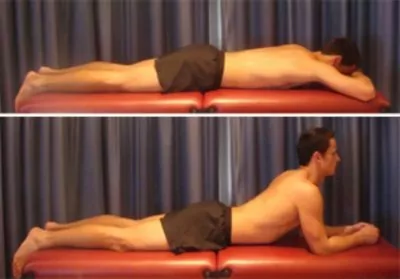
Lumbar Extension in Lying
Begin lying on your front with your hands in a push-up position as demonstrated (figure 5). Slowly straighten your arms, keeping your lower back relaxed and allowing your back to drop into an arch. Go as far as you comfortably can without increasing your symptoms and then return back down. Repeat 10 times provided there is no increase in symptoms. Repeat 5 times daily.
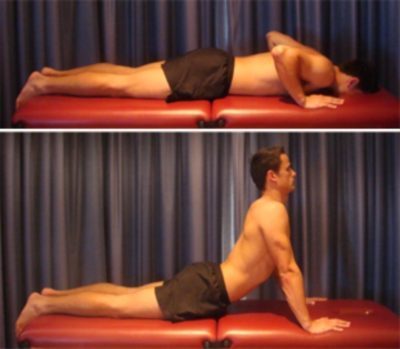
Intermediate Exercises

Members Only ContentBecome a PhysioAdvisor Member to gain full access to this exclusive content. For more details see Become a Member. Already a member? Login Now
Advanced Exercises

Members Only ContentBecome a PhysioAdvisor Member to gain full access to this exclusive content. For more details see Become a Member. Already a member? Login Now
Other Exercises

Members Only ContentBecome a PhysioAdvisor Member to gain full access to this exclusive content. For more details see Become a Member. Already a member? Login Now
Rehabilitation guide for a lumbar disc bulge

Members Only ContentBecome a PhysioAdvisor Member to gain full access to this exclusive content. For more details see Become a Member. Already a member? Login Now
 Find a Physio
Find a Physio
Find a physiotherapist in your local area to treat a lumbar disc bulge.
 Physiotherapy products for a lumbar disc bulge
Physiotherapy products for a lumbar disc bulge
Some of the most commonly recommended products by physiotherapists to hasten healing and speed recovery in patients with a lumbar disc bulge include:
-
 Wheat Bags
Wheat Bags -
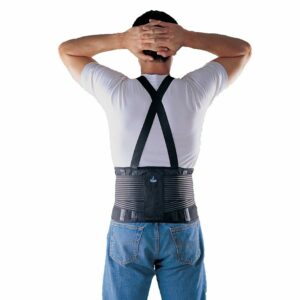 Oppo Industrial Back Support (OPP2169)
Oppo Industrial Back Support (OPP2169) -
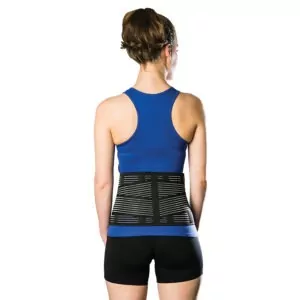 AllCare Ortho Light Back Support
AllCare Ortho Light Back Support -
 Premium Strapping Tape 38mm (Victor)
Premium Strapping Tape 38mm (Victor) -
 AllCare Pro-TENS Machine
AllCare Pro-TENS Machine -
 AllCare Spikey Massage Ball
AllCare Spikey Massage Ball -
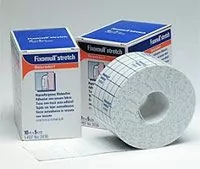 Fixomull Stretch 5cm x 10m
Fixomull Stretch 5cm x 10m -
 AllCare Instant Cold Pack (15 x 25cm)
AllCare Instant Cold Pack (15 x 25cm) -
 BakBalls
BakBalls -
 McKenzie Treat Your Own Back Book
McKenzie Treat Your Own Back Book -
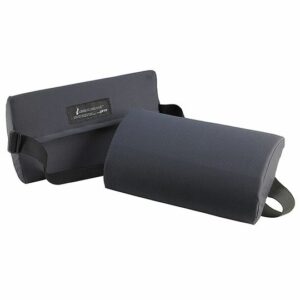 Lumbar Rolls (‘D’ Shaped)
Lumbar Rolls (‘D’ Shaped)
To purchase physiotherapy products for a lumbar disc bulge click on one of the above links or visit the PhysioAdvisor Shop.

Other Exercises
- Lower Back Flexibility Exercises.
- Lower Back Strengthening Exercises.
- Beginner Pilates Exercises.
- Massage Ball Exercises.
- Cardiovascular Exercise.
- Core Stability Exercises.
- Arm Strengthening Exercises.
- Leg Strengthening Exercises.
- Upper Body Gym Exercises.
- Lower Body Gym Exercises.
 Recommended Reading
Recommended Reading
- Correct Posture
- Postural Taping
- Correct Lifting
- Ergonomic Computer Setup
- Ice or Heat
- Investigations
- Choosing a School bag
- R.I.C.E. Regime
- Lower Back Pain Diagnosis Guide
- Understanding Pain
- Why is my injury not improving?
Become a PhysioAdvisor Member

Link to this Page
If you would like to link to this article on your website, simply copy the code below and add it to your page:
<a href="https://physioadvisor.com.au/injuries/lower-back/lumbar-disc-bulge”>Lumbar Disc Bulge – PhysioAdvisor.com</a><br/>June 14, 2018 - Detailed physiotherapy information on a bulging disc, also known as lumbar disc bulge or slipped disc at Physioadvisor.com.au.
Return to the top of Lumbar Disc Bulge.

